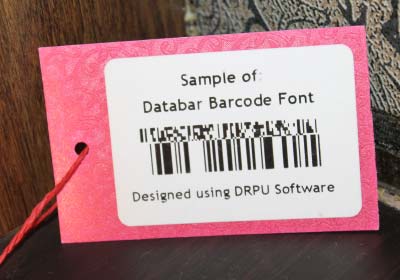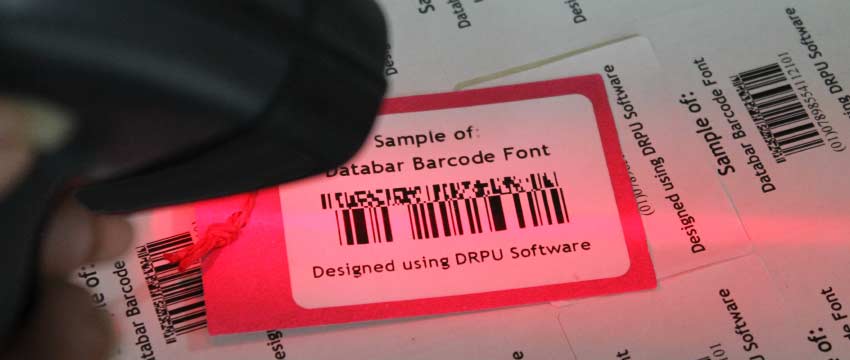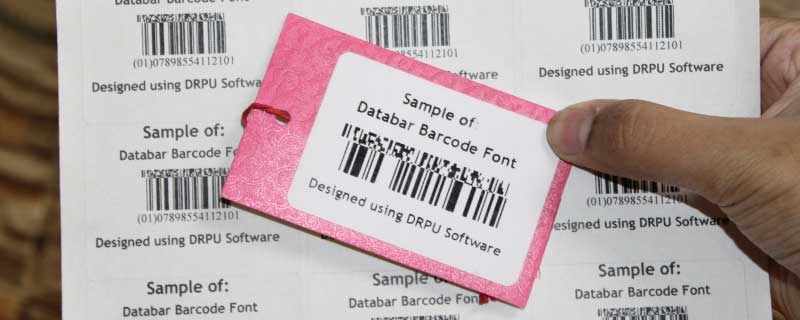Databar (formerly known as Reduced Space Symbology or RSS) is a family of linear barcode symbologies that have been developed to address specific requirements for data capture in various industries. While Databar barcodes offer several benefits over traditional barcodes, they also have some limitations that should be considered when selecting a barcode type. In this answer, we will discuss the limitations of using a Databar barcode in detail.
Limitations of Using a Databar Barcode
-
Limited Data
Capacity:
One of the primary limitations of using Databar barcodes is their limited data capacity. While Databar Expanded can hold up to 174 characters, most other Databar symbologies can only encode up to 14 digits or characters. This is because Databar was designed to be a compact symbology that can fit on small items like pharmaceutical products or produce, where there may not be enough space for larger barcodes. While this is sufficient for some applications, it may not be suitable for those requiring more data.
-
Limited Read Range:
Another limitation of Databar barcodes is their limited read range. Databar barcodes have a maximum read range of about 4 inches, which is much lower than that of other barcode symbologies like Code 128 or Code 39. This means that Databar barcodes may not be suitable for applications where long-range scanning is required.
-
Limited Industry
Support:
Databar barcodes are primarily used in the retail industry, particularly for tracking perishable goods like fresh produce or meat. While they are gaining popularity in other industries like healthcare and logistics, they are not as widely adopted as other barcode symbologies like Code 128 or QR codes. This means that it may be difficult to find devices or software that support Databar barcodes, especially in regions where they are not commonly used.
-
Limited Barcode Scanner
Compatibility:
Not all barcode scanners are capable of reading Databar barcodes. This is because Databar is a relatively new barcode symbology, and some older barcode scanners may not support it. This can be a problem for businesses that have existing barcode scanning equipment that may need to be replaced or upgraded to support Databar.
-
Limited Error
Correction:
Databar barcodes have limited error correction capabilities compared to other barcode symbologies like QR codes or Data Matrix codes. This means that if part of the barcode is damaged or obscured, it may be difficult or impossible to read. This is particularly problematic in applications where the barcode is exposed to harsh environments or where the barcode is likely to be damaged.
-
Limited International
Recognition:
While Databar is a globally recognized barcode symbology, it is not as widely recognized as some other symbologies like Code 128 or QR codes. This can be a problem for businesses that operate internationally or sell products globally, as they may need to use multiple barcode symbologies to ensure their products are compatible with local scanning systems.
Generate a Databar Barcode
Databar (formerly known as Reduced Space Symbology or RSS) is a type of barcode used for various applications, including retail, healthcare, and logistics. Generating a Databar barcode can be done with the help of specialized software, online tools, or programming libraries.
Here are the steps to generate a Databar barcode using different methods:
-
Using Specialized
Software:
There are various software programs available for generating Databar barcodes, such as Bartender, Labeljoy, and NiceLabel. These software programs allow you to create and customize Databar barcodes with different data types and sizes.
To generate a Databar barcode using specialized software, follow these steps:
Open the software program and select the Databar symbology.
Enter the data that you want to encode in the barcode.
Customize the barcode properties, such as size, orientation, and colors.
Preview the barcode and make any necessary adjustments.
Print the barcode on a label or export it as an image file.
-
Using Online Tools:
There are many free online barcode generators that support Databar barcode generation, such as Barcodes Inc, Online Barcode Generator, and Barcodespider. These tools allow you to generate a Databar barcode quickly and easily without installing any software.
To generate a Databar barcode using online tools, follow these steps:
Visit an online barcode generator that supports Databar symbology.
Select the Databar symbology and enter the data that you want to encode in the barcode.
Customize the barcode properties, such as size, orientation, and colors.
Preview the barcode and make any necessary adjustments.
Download the barcode as an image file or print it directly from the web page.
-
Using Programming
Libraries:
Developers can generate Databar barcodes programmatically using programming libraries that support Databar symbology, such as ZXing, Bytescout BarCode Generator SDK, and OnBarcode. These libraries provide APIs for generating and customizing Databar barcodes in various programming languages.

To generate a Databar barcode using programming libraries, follow these steps:
Install the programming library that supports Databar symbology.
Use the library's API to create a Databar barcode object.
Set the barcode properties, such as data, size, orientation, and colors.
Render the barcode object as an image or vector file.
Save the barcode to a file or print it directly from the application.
Conclusion:Generating a Databar barcode is a simple and straightforward process that can be done using specialized software, online tools, or programming libraries. The choice of method depends on the user's needs and expertise.
Print a Databar Barcode
Printing a Databar barcode requires certain considerations to ensure that it is scannable and readable by a barcode scanner. The printing process involves selecting the appropriate printing method, printer resolution, and substrate to ensure the barcode's quality and durability.
-
There are various printing methods that can be used to print Databar barcodes, including thermal transfer printing, direct thermal printing, and inkjet printing. Thermal transfer printing is a popular method for printing Databar barcodes because it produces high-quality, long-lasting barcodes. This method uses a thermal transfer ribbon to transfer the barcode image onto the substrate. Direct thermal printing, on the other hand, uses heat-sensitive paper to print the barcode. Inkjet printing can also be used to print Databar barcodes, but it is not as popular as thermal transfer or direct thermal printing.
-
The printer resolution is another important consideration when printing Databar barcodes. The printer resolution refers to the number of dots per inch (dpi) that the printer can produce. A higher dpi produces a more detailed and crisp barcode. The recommended printer resolution for Databar barcodes is at least 203 dpi. However, some applications may require a higher resolution of 300 dpi or more, especially for small or complex barcodes.
-
The substrate is also an important consideration when printing Databar barcodes. The substrate is the material onto which the barcode is printed, and it can affect the barcode's durability and readability. Some common substrates used for printing Databar barcodes include paper, cardstock, and synthetic materials such as polyester or polypropylene. The substrate should be smooth and clean to ensure that the barcode prints clearly and can be scanned accurately.
-
Once the appropriate printing method, printer resolution, and substrate have been selected, the next step is to generate the Databar barcode image. This can be done using a barcode software program, such as BarTender, NiceLabel, or Labeljoy, which can generate the barcode image based on the input data and the barcode symbology. The generated barcode image can then be sent to the printer for printing.
-
It is important to ensure that the barcode is printed with sufficient contrast between the bars and spaces to ensure that it can be easily scanned. This can be achieved by using a black barcode image on a white background or a white barcode image on a black background. It is also important to ensure that the barcode is printed at the correct size and with the correct quiet zone, which is the area of white space that surrounds the barcode.
-
In addition to ensuring that the barcode is printed correctly, it is also important to ensure that the printed barcode is stored and handled properly to prevent damage or smudging. The printed barcode should be stored in a dry and cool environment and should be handled with clean, dry hands to avoid smudging or smearing the barcode image.
Conclusion:Printing a Databar barcode requires selecting the appropriate printing method, printer resolution, and substrate, generating the barcode image using a barcode software program, and ensuring that the barcode is printed with sufficient contrast and at the correct size and quiet zone. Proper storage and handling of the printed barcode are also important to ensure that it remains scannable and readable.
Scan a Databar Barcode
To scan a Databar barcode, you need a barcode scanner or reader. The process of scanning a Databar barcode involves capturing the barcode's image using the scanner's optical sensor, decoding the barcode data using software, and transmitting the decoded data to a computer or other device.

Here are the general steps to scan a Databar barcode:
- 01 Position the
Scanner
Hold the scanner about 2-6 inches from the barcode and keep the scanner perpendicular to the barcode. If the scanner is too close or too far away, it may not read the barcode correctly.
- 02 Aim the
Scanner
Position the scanner so that the center of the barcode is within the scanner's field of view. Many scanners have an aiming guide to help you aim accurately.
- 03 Trigger the
Scanner
Depending on the scanner type, you may need to press a button, pull a trigger, or simply point the scanner at the barcode to activate the scanning process. Some scanners may also have automatic triggering, which means they will scan the barcode as soon as they detect it.
- 04 Wait for
Confirmation
After the scanner has captured the barcode image, it will decode the barcode data and transmit it to the connected device. You may hear a beep or see a light on the scanner indicating that the barcode has been successfully scanned.
- 05 Verify the
Data
Once the scanner has transmitted the barcode data to the connected device, verify that the data has been captured correctly. You can use a barcode scanning software or application to view the decoded data.
It's worth noting that different types of Databar barcodes may have different scanning requirements, such as different scanning distances or angles. Always refer to the barcode scanner's user manual for specific instructions on scanning Databar barcodes.
Types of Devices that Can Read a Databar Barcode
Databar barcodes can be read by a variety of devices, including handheld barcode scanners, smartphone cameras, and fixed mount scanners. The type of device required to read a Databar barcode depends on the size of the barcode, the scanning distance, and the environment in which it is being scanned.
-
Handheld barcode scanners are the most common type of device used to read Databar barcodes. These devices are typically used in retail environments to scan product barcodes at the point of sale. Handheld scanners come in a variety of sizes and shapes, from small and portable devices to larger, more industrial-grade scanners designed for high-volume scanning.
-
Smartphones with built-in cameras can also read Databar barcodes using barcode scanning apps. These apps use the phone's camera to capture an image of the barcode and then decode the information encoded in the barcode. Barcode scanning apps are widely available and can be used by consumers to scan barcodes in retail stores, as well as by employees to track inventory in warehouses and other settings.
-
Fixed mount scanners are another type of device that can read Databar barcodes. These scanners are typically used in industrial settings where items are moving on a conveyor belt, and the scanning process needs to be automated. Fixed mount scanners can be configured to read Databar barcodes at a variety of distances and angles, making them ideal for high-volume scanning applications.
-
In addition to handheld scanners, smartphones, and fixed mount scanners, some other devices can read Databar barcodes. For example, some point of sale systems have built-in barcode scanners that can read Databar barcodes, and some self-checkout kiosks also use barcode scanners to scan product barcodes.
Summary:Databar barcodes can be read by a wide variety of devices, making them a versatile and widely adopted barcode format. The choice of scanning device depends on the specific application, but there are many options available to meet the needs of different industries and environments.
Databar Barcode Can be Used Internationally
Databar, also known as Reduced Space Symbology (RSS), is a family of barcodes that can encode a variety of data types in a compact format. Databar barcodes were developed by GS1, an international organization that sets standards for supply chain management and e-commerce. As such, Databar barcodes can be used internationally as long as they comply with GS1 standards.
-
GS1 is a global organization that sets standards for a wide range of industries, including retail, healthcare, and logistics. GS1 standards ensure that products and services are identified and tracked throughout the supply chain, which facilitates efficient and accurate inventory management, shipping, and billing.
-
Databar barcodes are designed to be used in a variety of industries, including retail, healthcare, and logistics. For example, Databar barcodes can be used to encode product information such as the manufacturer, product type, and expiration date. In the healthcare industry, Databar barcodes can be used to encode patient information, medication details, and dosage instructions. In logistics, Databar barcodes can be used to track shipments and inventory levels.
-
To ensure that Databar barcodes can be used internationally, GS1 has established guidelines for their use. These guidelines include specifications for the structure and encoding of Databar barcodes, as well as guidelines for their placement on products and packaging.
-
In order to comply with GS1 standards, businesses must register for a GS1 company prefix. This prefix is used to generate unique identification numbers for products and services, which are then encoded in Databar barcodes. The company prefix also ensures that Databar barcodes can be read and decoded by scanners and software systems that are compatible with GS1 standards.
-
In addition to complying with GS1 standards, businesses that use Databar barcodes internationally should also consider the specific requirements of the countries in which they operate. For example, some countries have regulations regarding the use of barcodes for specific products or industries. Businesses should also ensure that their Databar barcodes are compatible with the scanning and inventory management systems used by their international partners and customers.
In summary, Databar barcodes can be used internationally as long as they comply with GS1 standards. To ensure compliance, businesses should register for a GS1 company prefix and follow guidelines for the structure and encoding of Databar barcodes. Businesses should also consider the specific requirements of the countries in which they operate, and ensure that their Databar barcodes are compatible with the scanning and inventory management systems used by their international partners and customers.
